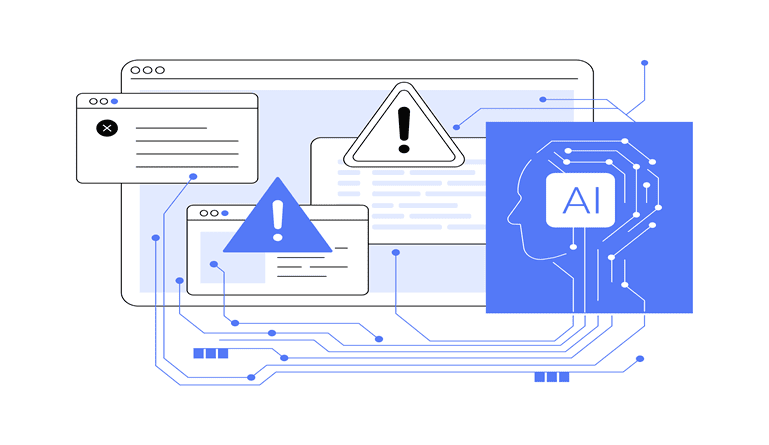The importance of robust disaster recovery planning cannot be overstated. As businesses increasingly rely on complex technological infrastructures, the potential impact of disruptions – whether from natural disasters, cyber-attacks, or system failures – has grown exponentially. Traditional disaster recovery strategies, while valuable, often fall short in addressing the speed, scale, and complexity of modern business operations.
Enter Artificial Intelligence (AI), a transformative force revolutionizing disaster recovery planning. By leveraging advanced algorithms, machine learning, and predictive analytics, AI enhances our ability to anticipate, prepare for, and respond to potential disasters with unprecedented accuracy and efficiency. This blog post explores the pivotal role of AI in shaping the future of predictive disaster recovery planning, offering insights for executive technology professionals seeking to fortify their organizations against unforeseen disruptions.
Understanding Predictive Disaster Recovery Planning
Predictive disaster recovery planning is an advanced approach to business continuity that goes beyond traditional reactive measures. At its core, it involves using data analysis and forecasting techniques to anticipate potential disasters, assess their likely impact, and develop proactive strategies to mitigate risks and ensure rapid recovery.
Key components of predictive disaster recovery planning include:
-
Risk Assessment
Identifying potential threats and vulnerabilities specific to an organization’s infrastructure and operations.
-
Impact Analysis
Evaluating the potential consequences of various disaster scenarios on business processes, data integrity, and overall operations.
-
Resource Planning
Allocating personnel, technology, and financial resources based on predicted needs and priorities.
-
Scenario Modeling
Creating and testing various disaster scenarios to refine response strategies.
-
Continuous Monitoring
Implementing systems to detect early warning signs of potential disasters.
Limitations of Traditional Methods Disaster Recovery Planning
Traditional methods of disaster recovery planning have relied heavily on historical data, manual risk assessments, and periodic testing of recovery procedures. While these approaches have served businesses well in the past, they are increasingly inadequate in the face of today’s dynamic threat landscape. Some limitations of traditional methods include:
-
Limited Scope
Traditional plans often focus on a narrow range of scenarios, potentially leaving organizations vulnerable to unforeseen threats.
-
Static Nature
Once created, traditional plans are often updated infrequently, failing to adapt to rapidly changing environments.
-
Resource Inefficiency
Without precise predictions, organizations may over-allocate resources to certain areas while under-preparing for others.
-
Slow Response Times
Manual processes and decision-making can lead to delayed responses in critical situations.
-
Lack of Real-time Insights
Traditional methods struggle to incorporate real-time data and emerging trends into their assessments.
These limitations underscore the need for more sophisticated, dynamic approaches to disaster recovery planning – a need that AI is uniquely positioned to address.
( Also Read: The Ultimate Guide to AI in Cybersecurity )
The Impact of AI on Disaster Recovery
Artificial Intelligence is transforming disaster recovery planning by introducing unprecedented levels of accuracy, speed, and adaptability. By leveraging machine learning algorithms, natural language processing, and advanced data analytics, AI enhances every aspect of the disaster recovery lifecycle.
Here’s how AI technologies are improving predictive accuracy in disaster recovery:
-
Advanced Pattern Recognition
Machine learning algorithms can analyze vast amounts of historical and real-time data to identify subtle patterns and correlations that might escape human analysts. This capability allows for more accurate prediction of potential disaster scenarios and their likely outcomes.
-
Real-time Data Processing
AI systems can continuously ingest and process data from multiple sources, including IoT devices, social media, weather forecasts, and network logs. This real-time analysis enables organizations to detect early warning signs of impending disasters and respond proactively.
-
Predictive Modeling
AI can create sophisticated predictive models that simulate various disaster scenarios and their potential impacts on an organization’s specific infrastructure and processes. These models can be continuously updated with new data, ensuring that predictions remain relevant and accurate.
-
Automated Risk Assessment
AI algorithms can automatically evaluate and prioritize risks based on multiple factors, including likelihood, potential impact, and organizational vulnerabilities. This automated assessment provides a more comprehensive and objective view of an organization’s risk landscape.
-
Natural Language Processing (NLP)
NLP capabilities allow AI systems to analyze unstructured data sources, such as news reports, social media posts, and internal communications, to identify emerging threats and trends that might affect disaster recovery efforts.
AI-Driven Risk Assessment and Disaster Recovery
AI applications in risk assessment and resource allocation include:
-
Intelligent Threat Detection
AI-powered security systems can identify and respond to cyber threats in real-time, often preventing or mitigating potential disasters before they occur.
-
Predictive Maintenance
By analyzing sensor data from critical infrastructure components, AI can predict equipment failures and schedule preventive maintenance, reducing the risk of system-related disasters.
-
Dynamic Resource Allocation
AI algorithms can optimize the allocation of disaster recovery resources based on real-time risk assessments, ensuring that critical assets are protected without overcommitting resources to low-risk areas.
-
Automated Disaster Response
In the event of a disaster, AI systems can automatically initiate predefined response protocols, such as data backups, system shutdowns, or failovers, minimizing human error and response times.
-
Scenario-based Planning
AI can generate and analyze thousands of potential disaster scenarios, helping organizations develop more comprehensive and adaptable recovery strategies.
By leveraging these AI capabilities, organizations can move from reactive to proactive disaster recovery planning, significantly enhancing their resilience in the face of potential disruptions.
Benefits of Integrating AI in Disaster Recovery
The integration of AI into disaster recovery planning offers numerous benefits that can significantly enhance an organization’s ability to prepare for, respond to, and recover from potential disasters. Some key advantages include:
-
Reduced Downtime
AI-powered predictive analytics can identify potential system failures or vulnerabilities before they lead to significant downtime. By enabling proactive maintenance and targeted interventions, AI helps minimize the duration and frequency of service interruptions.
-
Improved Response Times
Automated threat detection and response systems powered by AI can initiate recovery procedures within seconds of detecting an anomaly, dramatically reducing the time between incident occurrence and resolution.
-
Cost-Effectiveness
By optimizing resource allocation and reducing the impact of potential disasters, AI-driven disaster recovery planning can lead to significant cost savings. Organizations can avoid overinvesting in unnecessary redundancies while ensuring critical systems are adequately protected.
-
Enhanced Decision-Making
AI systems can provide real-time insights and recommendations during a crisis, supporting faster and more informed decision-making by IT leaders and executives.
-
Scalability
AI-powered disaster recovery solutions can easily scale to accommodate growing data volumes and increasingly complex IT environments, ensuring that protection remains comprehensive as an organization expands.
-
Continuous Improvement
Machine learning algorithms can analyze the effectiveness of disaster recovery efforts over time, continuously refining and improving response strategies.
Real-World Benefits of AI in Disaster Recovery
To illustrate these benefits, consider the following real-world examples:
-
Case Study
Global Financial Institution A large multinational bank implemented an AI-driven disaster recovery system that continuously monitored its global network for potential threats. When a coordinated cyber-attack targeted several of its data centers, the AI system detected the anomalous activity within seconds, automatically initiating containment protocols and alerting the security team. The rapid response prevented data loss and limited the attack’s spread, reducing potential downtime from days to hours and saving millions in potential losses.
-
Case Study
E-commerce Giant A major e-commerce company leveraged AI to optimize its disaster recovery resource allocation. By analyzing historical data and current trends, the AI system predicted peak stress periods for the company’s infrastructure and adjusted backup and failover resources accordingly. This dynamic allocation reduced the company’s disaster recovery costs by 30% while improving its ability to handle traffic spikes during high-demand events.
-
Case Study
Healthcare Provider Network A network of hospitals and clinics implemented an AI-powered predictive maintenance system for its critical medical equipment. The system analyzed sensor data to predict potential failures, scheduling preventive maintenance during off-peak hours. This approach reduced unplanned downtime by 75% and ensured that life-saving equipment was consistently available when needed.
These examples demonstrate how AI can significantly enhance the effectiveness, efficiency, and reliability of disaster recovery efforts across various industries.
Challenges and Considerations
While the benefits of integrating AI into disaster recovery planning are substantial, organizations must also be aware of potential challenges and considerations:
-
Data Privacy and Security Concerns
AI systems must access vast data to function effectively. This raises important questions about data privacy, especially when dealing with sensitive information. Organizations must ensure that their AI-powered disaster recovery solutions comply with relevant data protection regulations and implement robust security measures to protect against data breaches.
-
Need for Skilled Personnel
Implementing and maintaining AI-driven disaster recovery systems requires specialized skills. Organizations may face challenges in recruiting and retaining AI experts, data scientists, and machine learning specialists.
-
Integration with Existing Systems
Incorporating AI into established disaster recovery frameworks can be complex, potentially requiring significant changes to existing processes and technologies.
-
Algorithmic Bias and Transparency
AI systems can inadvertently perpetuate or amplify biases in their training data. Ensuring the fairness and transparency of AI-driven decisions in disaster recovery contexts is crucial.
-
Over-reliance on AI
While AI can significantly enhance disaster recovery capabilities, it’s important not to become overly dependent on automated systems. Human oversight and decision-making remain critical, especially in complex or unprecedented scenarios.
-
Cost of Implementation
The initial investment in AI-powered disaster recovery solutions can be substantial, potentially posing a barrier for smaller organizations or those with limited IT budgets.
Strategies for Effective AI-Driven Disaster Recovery
To address these challenges effectively, consider the following strategies:
-
Develop a Comprehensive Data Governance Framework
Establish clear policies and procedures for data collection, storage, and usage in AI-driven disaster recovery systems. Ensure compliance with relevant regulations such as GDPR, CCPA, or industry-specific standards.
-
Invest in Training and Talent Development
Develop in-house AI expertise through training programs and partnerships with academic institutions. Consider creating cross-functional teams that combine AI specialists with traditional IT and disaster recovery experts.
-
Adopt a Phased Implementation Approach
Start with pilot projects in specific areas of disaster recovery planning before scaling to enterprise-wide implementation. This allows for learning and adjustment with minimal disruption to existing processes.
-
Prioritize Explainable AI
Choose AI solutions that offer transparency in their decision-making processes. This helps build trust in the system and allows for easier auditing and refinement of AI-driven strategies.
-
Maintain Human Oversight
Establish clear protocols for human intervention and decision-making in AI-driven disaster recovery processes. Regularly review and validate AI recommendations to ensure they align with organizational goals and values.
Conduct Regular AI Audits: Implement a system of regular audits to assess the performance, fairness, and effectiveness of AI-driven disaster recovery solutions. Use these audits to identify areas for improvement and address any emerging issues.
-
Explore Flexible Financing Options
Consider cloud-based AI solutions or partnerships with AI service providers to reduce upfront costs and allow for more scalable implementation.
By proactively addressing these challenges, organizations can maximize the benefits of AI in their disaster recovery planning while minimizing potential risks and drawbacks.
Final Thought
Integrating Artificial Intelligence into predictive disaster recovery planning represents a significant leap forward in our ability to protect critical business operations from unforeseen disruptions. By harnessing the power of machine learning, advanced analytics, and automated decision-making, AI enables organizations to move from reactive to proactive disaster recovery strategies.
The benefits of this approach are clear: reduced downtime, improved response times, optimized resource allocation, and enhanced decision-making capabilities. These advantages translate into tangible business outcomes, including cost savings, improved customer satisfaction, and increased organizational resilience.
However, the journey towards AI-driven disaster recovery is not without its challenges. Data privacy concerns, the need for specialized skills, and the complexity of integration with existing systems are all significant considerations that must be carefully addressed.
As executive technology professionals, the imperative is clear: embracing AI in disaster recovery planning is no longer a luxury but a necessity in today’s rapidly evolving digital landscape. By understanding both AI’s potential and challenges in this context, leaders can make informed decisions that balance innovation with pragmatism, ultimately building more resilient and adaptive organizations.
The future of disaster recovery is predictive, adaptive, and intelligent. By leveraging AI technologies today, organizations can ensure they are well-prepared to face the uncertainties of tomorrow, safeguarding their operations, data, and ultimately, their bottom line.








